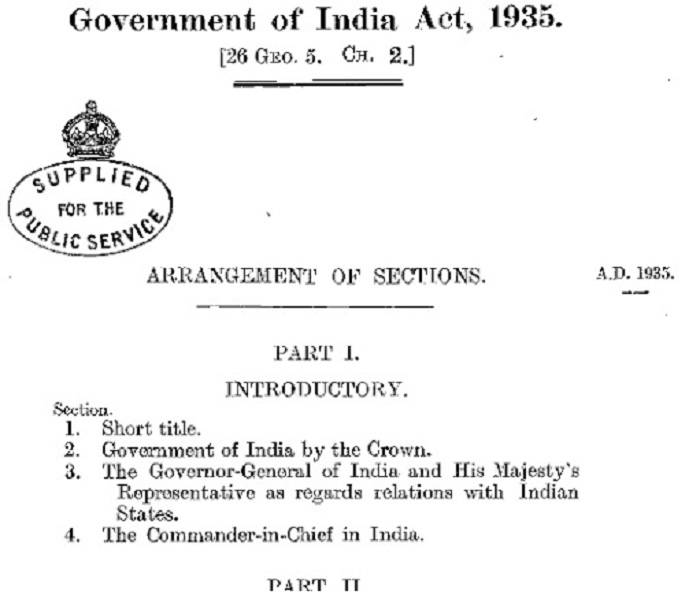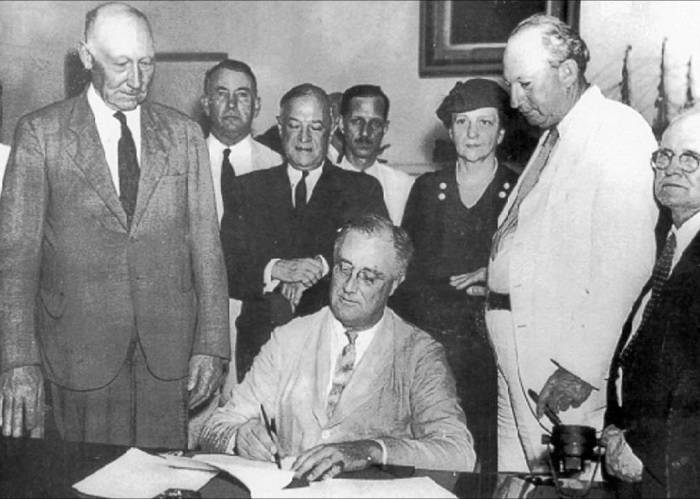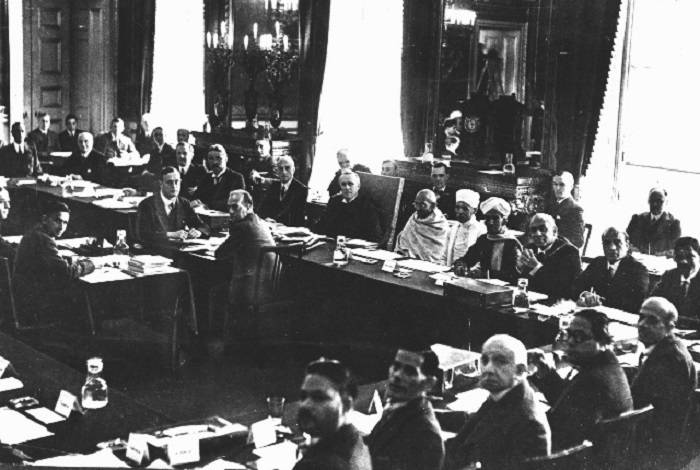The Government of India Act, 1935 that was passed initially in the month of August that year is considered the longest Act (British) of Parliament passed till such time. It was later split retroactively into two different Acts namely the Government of India Act, 1935 (26 Geo. 5 & 1 Edw. 8 c. 2), including 321 sections and 10 schedules; and the Government of Burma Act, 1935 (26 Geo. 5 & 1 Edw. 8 c. 3), encompassing 159 sections and 6 schedules. Materials of the Government of India Act, 1935 was mainly taken from the White Paper of 1933, the report of the Simon Commission, from the Third Round Table Conference discussions and the Joint select committees’ reports. Significant aspects of the Act included end of the diarchy system introduced by the Government of India Act, 1919 and introduction of diarchy at the Centre; establishment of a Federal Court; and provision for setting up a “Federation of India” among others.
Circumstances Leading to the Act
Since the late 19th century the Indian leaders were increasingly pressing for constitutional reforms in India and a greater role in the government in India. Contribution of Indians in supporting the British during the First World War also led even the more conservative British political leaders to acknowledge the need of constitutional change so as to expand participation of Indians in the government of the British Indian Empire. The Government of India Act, 1919 was passed in such pursuit. The Act encompassed reforms advised in the report of the Viceroy, Lord Chemlsford and the Secretary of State for India, Edwin Montagu. It initiated a dual form of government, diarchy for the major provinces where control of some areas of government in each such province would be under the control of Government of ministers who would be accountable to the Provincial Council. These areas included in the “transferred list” encompassed agriculture, education, health and supervision of local government. On the other hand other areas of government included in the ‘’reserved list’’ consisting of foreign affairs, defence (the military) and communications would be under the Viceroy’s control. However control over money still remained in the hands of the British officials.

Image Credit : http://www.padmad.org/2013/12/government-of-india-act-of-1935-audio.html
The goal to review constitutional arrangements of India as well as the princely states that were willing to give consent to it was already there. Although three Round Table Conferences were organized by the British Government between 1930 and 1932 to discuss India’s constitutional reforms, the agreement on most of the significant details on the way the federation would function practically, was intercepted majorly due to the division of Congress and Muslim representatives. Britain’s new National Government dominated by Conservative Party with Ramsay MacDonald as Prime Minister of the United Kingdom resolved to draft proposals that resulted in publishing of a white paper in March1933 that was based on the Third Round Table Conference. The proposals of the white paper were reviewed from April 1933 to November 1934 by a joint parliamentary Select Committee that was chaired by Lord Linlithgow, although Winston Churchill and several backbench Conservatives were against it. The Joint Select Committee report was approved by the House of Commons in December 1934. The framing of the Government of India Bill was based on the white paper. It became quite lengthy consisting of 473 clauses and 16 schedules. The Labour Party was against the Third Reading of the bill due to the absence of any specific assurance of ‘dominion status’ for India. It garnered Royal Assent on July 24, 1935 and on August 2 that year it was passed into law.
Overview of Vital Aspects of the Act
Some of the most important features of the Act included bestowing more power to the British Indian provinces abolishing the diarchy system introduced by the Government of India Act, 1919 and introducing diarchy at centre; introduction of advisory council while annulling Indian Council; provision for setting up a “Federation of India” including British India territories as also some or all the princely states; initiating direct elections, extension of franchise and increasing size of legislatures; setting up of a Federal Court; instruments safeguarding the minorities; and partially restructuring provinces, for instance separation of Sindh from Bombay, split of Bihar and Orissa Province to separate provinces of Bihar and Orissa and complete separation of Burma from India.
Some of the Salient Features of the Act
The Diarchy System
In the diarchy system, some subjects were reserved by the British Government which were included in the reserved list. These consisted areas like Police, Foreign Relations/Policies, Revenue, Taxation, Publications/Press, Power Resources and Justice Department. The other areas including Education, Local Government, Forest Department, Public Health and Social Welfare were transferred to the Indians and came under the transferred list. While full control of the reserved subjects were in the hands of the British, they could exercise “special powers” on the transferred subjects as well, for instance they had power to alter any act or project that the Indians suggested. This act ensured that the executive authority of the centre was conferred on the Governor General. He would administer the subjects in the reserved list taking aid from three counsellors inducted by him, and that of the subjects in the transferred list taking advice from the Council of Ministers not exceeding ten. In case the Governor General differs with the advice of the Council of Ministers where an act involved his ‘special responsibilities’, then he would follow the direction of the Secretary of State.

Image Credit : https://www.youtube.com/watch?v=LNuztvoUK4g
Formation of Federation of India
The Federation of India that was recommended encompassed eleven British India provinces and six Chief Commissioners Provinces apart from the princely states that would willingly assent to join the federation. While it was mandatory for the British India provinces and the Chief Commissioners Provinces to join the Federation, it was voluntary in case of the princely states. The Instrument of Accession would contain the terms on which a state would enter the Federation. However establishment of Federation of India could never be materialised because of antagonistic approach from rulers of the princely states.
Absence of Preamble & Vagueness of British Promise of a Dominion Status
There was no preamble in the Act much in contrast to the Government of India Act, 1919. By this time the demand for constitutional equality with the existing Dominions constituting the British Empire like the Union of South Africa, the Irish Free State and Australia was gradually bolstering among Indians centred on British India, signifying a call for complete power within the British Commonwealth. However a doubt prevailed among a section of the British political circle regarding the capability of Indians in running India on this basis. They opined that Dominion status might be planned after an extended tenure of continuous constitutional development maintaining adequate “safeguards”. Hence an ambiguity in committing a dominion status prevailed with no preamble of the 1935 Act while maintaining the preamble of the Government of India Act, 1919 although the rest of the 1919 Act was repealed. Thus a latent strain between the Indians and the British continued.
Lack of Any Bill of Rights
The Act was void of any “bill of rights” as it was usual with Commonwealth constitutional legislation prevailing that time but was however contrary to many of the modern constitutions of that time. Nevertheless incorporating such rights in the recommended Federation of India would have called for more complications as the nominally sovereign princely states were proposed to be included in the new body. Still a memorandum of August 28-30, 1928, called the Nehru Report that outlined a proposed new dominion status constitution for India and had a bill of rights led some to consider a different approach.

Image Credit : http://51989333.weebly.com/the-government-of-india-act.html
Nuances/Undertone of the Act
The Act was made in such a way that the British Government legally had the power to take back full control of the government any time at their convenience. Although a Diarchy was provided at the Centre by the Act, The British Government would continue to control the financial obligations, defence, foreign affairs of India apart from the British Indian Army through the Secretary of State for India, who on the other hand would direct and control the Governor-General of India – Viceroy of India. The British Government also had the power of making key appointments in the Railway Board and in the Reserve Bank of India (exchange rates). Consent of the Governor General would be necessary for placing any finance bill in the Central Legislature. Financing for British responsibilities as well as foreign liabilities were made, a minimum of 80% of the federal expenditures, without any voting and would be given top priority before consideration of any other claims. Superior authority and power including certifying power was vested upon the Viceroy who overlooked by the Secretary of State for India was permitted to rule as an autocrat. Through the Act the British also attempted to win support of the Muslims as they conceded most of the Fourteen Points of Jinnah.
Response of Indians Towards the Proposed Federation
Although the provincial portion of the Act that mainly followed the Simon Commission recommendations became effective automatically, the Federal part of the Act was not accepted by any significant Indian group. The obvious reason that came up was that no real power was vested in the hands of the Centre and practically no right was bestowed to the Indians in controlling the five aspects in any Government worth mentioning including day-to-day administration of the land; fiscal policy; currency and exchange of the country; external relations; and external and internal defence. Many of the stalwarts of the Indian independence movement censured the Act. Pandit Jawaharlal Nehru who later became the first Prime Minister of India following its independence called the Act a Charter of Slavery and a machine with strong brakes sans any engine. Muhammed Ali Jinnah who became the founder of Pakistan, a separate nation cut out of the Indian sub-continent during independence of India in 1947 called the Act “thoroughly rotten, fundamentally bad and totally unacceptable”.

Image Credit : http://www.vivacepanorama.com/the-government-of-india-act-1935/
Commencement of the Act
British government replaced Lord Willingdon with Lord Linlithgow as the new Viceroy of India. Linlithgow, who arrived in Bombay, India on April 17, 1936, was resolved to make the Act a success. The Act commenced on April 1, 1937 and as mandated by it, Provincial elections were conducted in British India in eleven provinces during the winter of 1936-37. While the Indian National Congress came to power in eight provinces, the All-India Muslim League remained unsuccessful in forming government in any province. However establishment of elected governments could not be made possible in most of the princely states due to defiance of the princes. Linlithgow made effort to launch the Federation of India but failed to make the princes accede in such pursuit. With break out of the Second World War, the establishment of the Federation was also deferred indefinitely. Linlithgow turned his focus in supporting the war effort and in September 1939 made an announcement that India was at war with Germany. Much of the Indian perspective in such matter was not positive as the Viceroy declared such a significant decision without consulting the elected representatives of the Indian people. In protest of such action of the Viceroy, the Congress ministries resigned in October and November 1939.
The Act was later repealed in India on January 26, 1950; in Pakistan and Bangladesh on March 23, 1956; and in the UK on November 19, 1998.


